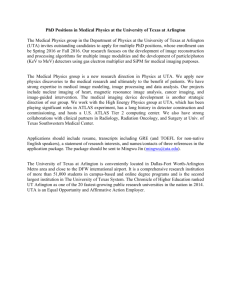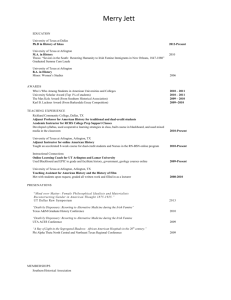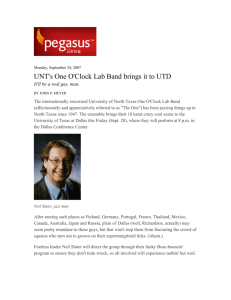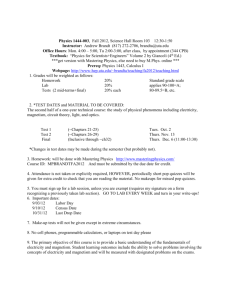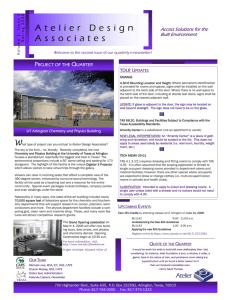From Learning Objectives to Outcomes | Carolyn Cason
advertisement
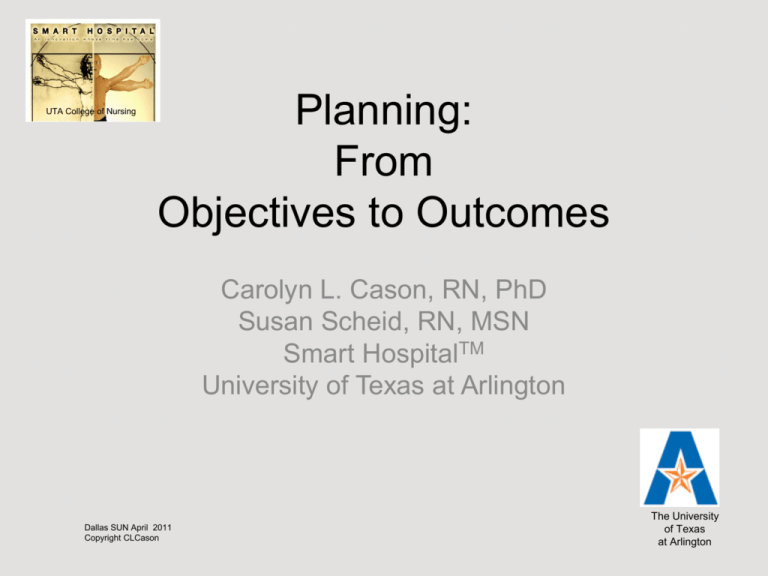
UTA College of Nursing Planning: From Objectives to Outcomes Carolyn L. Cason, RN, PhD Susan Scheid, RN, MSN Smart HospitalTM University of Texas at Arlington Dallas SUN April 2011 Copyright CLCason The University of Texas at Arlington Objectives UTA College of Nursing • Discuss core components to a healthcare simulation • Discuss the importance of outcomes evaluation and challenges to traditional assessments • Discuss the importance of validity, reliability, and feasibility as it relates to assessment • Discuss types of assessments and their application in healthcare education Dallas SUN April 2011 Copyright CLCason The University of Texas at Arlington Strategy for the Session UTA College of Nursing • Describe the process used to develop a near end-of-program clinical performance exam • Examine the – Validity, reliability and standardization challenges – Evaluation challenges – Performance outcomes • Describe the ways in which the outcomes – Guided exam revision – Informed curriculum/program effectiveness Dallas SUN April 2011 Copyright CLCason The University of Texas at Arlington Impetus for Exam UTA College of Nursing • Faculty desire for clinical performance assessment to complement the knowledge assessment obtained via the HESI Exit exam • Faculty search for a meaningful and comprehensive approach to evaluation of program outcomes • Faculty search for a way to benchmark/assess clinical competencies Dallas SUN April 2011 Copyright CLCason The University of Texas at Arlington UTA College of Nursing UTA College of Nursing Junior I Foundations, Assessment, Health Promotion Junior II Medical-Surgical Nursing, Psychiatric-Mental Health Nursing, Research Senior I Pediatric Nursing, OB Nursing, Critical Care Nursing Senior II Community Health, Leadership & Management, Nursing Trends, Gerontology, Capstone Dallas SUN April 2011 Copyright CLCason The University of Texas at Arlington OSCE Objectives UTA College of Nursing • Provide safe patient care • Obtain focused objective & subjective assessment • Plan, implement and evaluate patient care based on nursing assessment & diagnosis • Communicate effectively & professionally with the patient and healthcare team • Complete appropriate documentation Dallas SUN April 2011 Copyright CLCason The University of Texas at Arlington Pilot: July 2010 UTA College of Nursing • Clinical Skills – Manual B/P; O2 administration, telephone order, IV management – NG insertion, IV start, urinary catheter insertion, restraints, I/O etc. • Patient Care Management – 1st day post-op bowel surgery – Post-op hemorrhage Dallas SUN April 2011 Copyright CLCason The University of Texas at Arlington Summer 2010 OSCE Dallas SUN April 2011 Copyright CLCason Summer 2010 OSCE Dallas SUN April 2011 Copyright CLCason UTA College of Nursing Lessons Learned Summer 2010 • More preparation of students and faculty needed • Skills check separate from patient care scenarios • Faculty involvement needed (Crucial) Dallas SUN April 2011 Copyright CLCason The University of Texas at Arlington UTA College of Nursing Lessons Learned Summer 2010 • Inconsistencies • Faculty decision to use OSCE as diagnostic assessment • Incorporate more simulation into Nursing curriculum Dallas SUN April 2011 Copyright CLCason The University of Texas at Arlington UTA College of Nursing Fall 2010 OSCE Changes • Increased faculty involvement • Increased preparation of students • Skills Check: separate day in context Dallas SUN April 2011 Copyright CLCason The University of Texas at Arlington UTA College of Nursing Fall 2010 OSCE Changes • Patient scenarios individual and private - confidential • Use OSCE as diagnostic tool for Capstone Clinical • Development of simulation for all levels of undergraduate nursing program Dallas SUN April 2011 Copyright CLCason The University of Texas at Arlington UTA College of Nursing Fall 2010 Outcomes Skills Validation Safety: • • • • Patient identification failure (15-21%) No allergy check (26-86%) Inconsistent hand hygiene (21-28%) Sterile procedure contamination (2332%) • Not using alcohol to clean skin or IV tubing ports (21-57%) Dallas SUN April 2011 Copyright CLCason The University of Texas at Arlington UTA College of Nursing Fall 2010 Outcomes Skills Validation Medication Administration: • Failure to draw up or give insulin correctly (23-31%) • Improper use of gloves (23-42%) • Recapping used needles (25-39%) • Inability to hang IVPB correctly (2832%) Dallas SUN April 2011 Copyright CLCason The University of Texas at Arlington N 4350 Capstone Skills Validation Indicates error Red= 60-80% Yellow = <80- 90% Green =>90% Patient: Collins and Jonas Student ________________________Date/Start time __________ Clinical Instructor ___ N = 76 Skill Yes No Patient Safety Percentages Correct Incorrect a. Introduced self/wearing ID 72 4 94.7% 5.3% b. Wash/gel hands on entry 69 7 90.8% 9.2% c. Identified patient 64 12 84.2% 15.8% d. Assessed allergies 56 20 73.7% 26.3% 1. Vital signs: Set values 2. 3. a. Blood Pressure: 64 12 84.2% 15.8% b. Pulse: 71 5 93.4% 6.6% c. Respirations: 71 5 93.4% 6.6% Oxygenation: a. Applied oxygen cannula correctly 72 4 94.7% 5.3% b. Set oxygen flow to 2L/min 71 5 93.4% 6.6% 58 18 76.3% 23.7% 52 24 68.4% 31.6% c. Correctly figured and drew up Regular insulin dose: Reg (4 units) (drew first) Correctly figured NPH insulin and drew up dose: (14 units). (18 units total in syringe) Wiped top of vials with alcohol 73 3 96.1% 3.9% d. Selected appropriate site 74 2 97.4% 2.6% e. Explained procedure 67 9 88.2% 11.8% f. Wore gloves for injection 58 18 76.3% 23.7% g. Cleaned skin with alcohol 69 7 90.8% 9.2% h. Aspirated 8 68 89.5% no 10.5% yes i. Recapped used needle 19 57 75% no 25% yes 70 6 92.1% 7.9% b. Adjusted rate of primary IV fluids from 75 mL/hr to 125 mL/hr Selected Ceftriaxone 1 g/50 mL 68 8 89.5% 10.5% c. Primed bag correctly 68 8 89.5% 10.5% d. Wiped ports with alcohol 58 18 76.3% 23.7% e. Lowered primary bag 48 28 63.2% 36.8% f. IVPB at correct rate: 100 mL/hr 68 8 89.5% 10.5% g. Unclamped IVPB so it would run 53 23 69.7% 30.3% h. Capped empty IVPB 49 27 64.5% 35.5% Insulin administration: a. b. 4. IV Medications: a. 5. Foley catheter insertion a. Explained procedure 69 7 90.8% 9.2% b. Applied sterile gloves without contamination 67 9 88.2% 11.8% 58 18 76.3% 23.7% c. Inserted Foley without contamination or verbalized errors in sterile technique. Patient Safety a. Left bed in low position 75 1 98.7% 1.3% b. Siderails up x 2, call light in reach 72 4 94.7% 5.3% c. Wash/gel on leaving room 60 16 79% 21% Evaluator: ___________________________________________________ Fall 2010 Scenarios UTA College of Nursing • Focused patient assessment, vital signs, recognize change in patient condition, independent nursing judgment and action • Capstone faculty – sometimes present during OSCE scenarios Dallas SUN April 2011 Copyright CLCason The University of Texas at Arlington Fall 2010 UTA College of Nursing Scenarios: OSCE Evaluation • Similar student performance concerns • Safety issues: – No patient identification ( 31-40%) – Inadequate hand hygiene (33- 44%) – Improper use of gloves (14%) • No medication administration required for scenarios except IV Fluid Dallas SUN April 2011 Copyright CLCason The University of Texas at Arlington Fall 2010 Skills and OSCE UTA College of Nursing Deficiencies in student performance • Related to lack of simulation experience • Inconsistency of evaluators and operators - 20 different people involved in check-offs - Standardized pre-recorded voice responses of manikins - Operators – differences in prompting with responses - Assistance given by evaluator varied Dallas SUN April 2011 Copyright CLCason The University of Texas at Arlington UTA College of Nursing Student Feedback Skills & OSCE Fall 2010 Most students (more than 70%) agreed or strongly agreed: • Time was sufficient • Helped meet learning objectives • Were able to transfer to clinical setting • Conducive to learning Dallas SUN April 2011 Copyright CLCason The University of Texas at Arlington UTA College of Nursing Student Feedback Skills & OSCE Fall 2010 Some students (30-40%) were neutral or disagreed: • Helped them gain confidence in role, skills, or clinical setting • Felt it was not realistic (40%) • Were not satisfied with method of learning Dallas SUN April 2011 Copyright CLCason The University of Texas at Arlington 1. Length of time was sufficient 2. Helped me meet learning objectives 3. Helped me gain confidence In RN role 4. Helped me gain confidence In skills 5. I am more confident in clinical setting 6. Able to transfer info to clinical setting 7. Able to transfer skills to clinical setting 8. Session fit well into course outcomes 9. Environment was conducive to learning 10. Session was realistic 11. Satisfied with method of learning 12 Standardized patient added to scenario Strongly agree Agree Neutral Disagree Strongly disagree N/A 37 40 9 4 0 0 90 28 43 13 4 2 0 90 22 38 19 8 3 0 90 66.7% 33.3% 17 44 19 8 2 0 90 67.8% 32.2% 15 37 24 11 3 0 90 57.8% 42.2% 25 53 6 4 2 0 90 86.7% 13.3% 20 49 10 4 2 0 85 81.2% 18.8% 16 42 16 4 4 0 82 70.7% 29.3% 20 46 8 7 2 0 83 79.5% 20.5% 19 29 19 11 3 0 81 59.3% 40.7% 22 28 20 8 4 0 82 61.0% 39.0% 19 25 13 0 4 3 68.8% 31.2% 260 N = 90 for # 1-6 474 See totals for # 7-12 176 73 31 3 Total # 64 S. Agree Or Agree 85.6% 78.9% Neutral Disagree or S. Disagree 14.4% 21.1% UTA College of Nursing Student Comments Four main categories of comments: • Realism - Some very real, some unrealistic • Liked individual thinking and action • Wanted immediate feedback (debriefing) • Confidence – mostly yes Dallas SUN April 2011 Copyright CLCason The University of Texas at Arlington UTA College of Nursing Student Suggestions Suggestions for Improvement: • Immediate debriefing • More simulation throughout program • Opportunities to practice & more information Dallas SUN April 2011 Copyright CLCason The University of Texas at Arlington Summary Fall 2010 OSCE UTA College of Nursing • Objectives stayed the same – Faculty wanted end of program evaluation – Student performance needed improvement • Reliability: multiple evaluators and operators • Validity: use as diagnostic tool • Feasibility: labor intensive, costly • Positive changes • More work needed Dallas SUN April 2011 Copyright CLCason The University of Texas at Arlington Spring 2011 Changes UTA College of Nursing Faculty Involvement: • Immediate feedback and debriefing by clinical instructors at time of scenario • Emphasis on OSCE as plan for Capstone Clinical • Scheduling of students by faculty Dallas SUN April 2011 Copyright CLCason The University of Texas at Arlington Spring 2011 Changes UTA College of Nursing • Reversed order of scenarios for realism • Revisions for consistency and standardization – Identical pre-recorded manikin voice responses – More instructions to students, faculty, operators, and evaluators Dallas SUN April 2011 Copyright CLCason The University of Texas at Arlington UTA College of Nursing Spring 2011 OSCE Outcomes • Preliminary results for skills validation – Similar safety and medication concerns • Slight improvement of hand hygiene • Faculty presence and participation – Less student anxiety – Favorable student responses • Overall improved outcomes? Dallas SUN April 2011 Copyright CLCason The University of Texas at Arlington UTA College of Nursing Planning from Objectives to Outcomes Program Outcome Objectives • Clinical Performance Assessment • Comprehensive approach to evaluation of program outcomes • Determine Clinical Competency before graduation Dallas SUN April 2011 Copyright CLCason The University of Texas at Arlington UTA College of Nursing Planning from Objectives to Outcomes Student Objectives for Skills and scenarios: • Provide safe patient care • Obtain a focused patient assessment • Plan, implement and evaluate patient care • Communicate effectively Dallas SUN April 2011 Copyright CLCason The University of Texas at Arlington Quality Assessment UTA College of Nursing • • • • • Dallas SUN April 2011 Copyright CLCason Reliable Valid Practical Replicable Generalizable The University of Texas at Arlington Thank You UTA College of Nursing Questions? Dallas SUN April 2011 Copyright CLCason The University of Texas at Arlington
